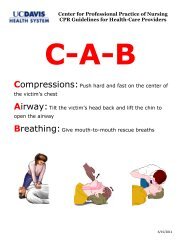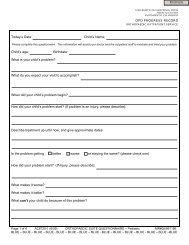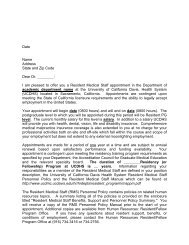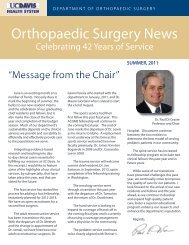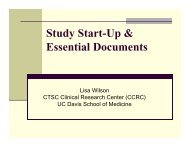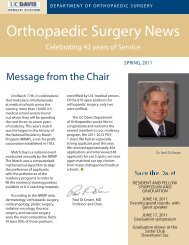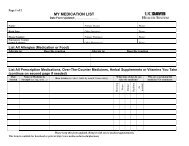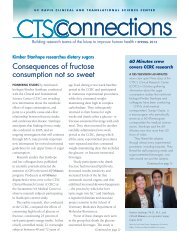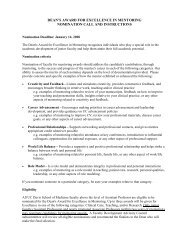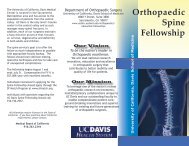Resident Handbook - UC Davis Health System
Resident Handbook - UC Davis Health System
Resident Handbook - UC Davis Health System
- No tags were found...
You also want an ePaper? Increase the reach of your titles
YUMPU automatically turns print PDFs into web optimized ePapers that Google loves.
Minimum Time Off between Scheduled Duty Periods - PGY-1 residents should have 10 hours,and must have eight hours, free of duty between scheduled duty periods. Intermediate-levelresidents [as defined by the Review Committee – PGY-2 for family medicine] should have 10hours free of duty, and must have eight hours between scheduled duty periods. They must haveat least 14 hours free of duty after 24 hours of in-house duty. <strong>Resident</strong>s in the final years ofeducation [as defined by the Review Committee – PGY3 for family medicine] must be preparedto enter the unsupervised practice of medicine and care for patients over irregular or extendedperiods. This preparation must occur within the context of the 80- hour, maximum duty periodlength, and one-day-off-in seven standards. While it is desirable that residents in their final yearsof education have eight hours free of duty between scheduled duty periods, there may becircumstances [as defined by the Review Committee –The Family Medicine Review Committeedefines such circumstances as: required continuity of care for a severely ill or unstable patient, ora complex patient with whom the resident has been involved; events of exceptional educationalvalue; or, humanistic attention to the needs of a patient or family. ] when these residents muststay on duty to care for their patients or return to the hospital with fewer than eight hours free ofduty. Circumstances of return-to-hospital activities with fewer than eight hours away from thehospital by residents in their final years of education must be monitored by the program director.Maximum Frequency of In-House Night Float - <strong>Resident</strong>s must not be scheduled for more thansix consecutive nights of night float. [The maximum number of consecutive weeks of night float,and maximum number of months of night float per year may be further specified by theReview Committee – for family medicine, night float experiences must not exceed 50 percent ofa resident’s inpatient experiences.}Maximum In-House On-Call Frequency- PGY-2 residents and above must be scheduled for inhousecall no more frequently than every-third-night (when averaged over a four-week period).At-Home Call - Time spent in the hospital by residents on at-home call must count towards the80-hour maximum weekly hour limit. The frequency of at-home call is not subject to the everythird-night limitation, but must satisfy the requirement for one-day-in-seven free of duty, whenaveraged over four weeks. At-home call must not be so frequent or taxing as to preclude rest orreasonable personal time for each resident.The Call Schedule is done by the Chief <strong>Resident</strong>, with input from residents, and in accordancewith the master schedule and our scheduling guidelines. The foremost aims of the call schedulesare to be equitable and to provide smooth, uninterrupted coverage of the clinical services, whilefollowing the ACGME work hour standards. To assure compliance with residency work hourrestrictions, residents must keep a log of hours worked including moonlighting and submit this tothe residency program via New Innovations.Page 122 of 153C:\Documents and Settings\dhutak\Desktop\rshb13.doc




